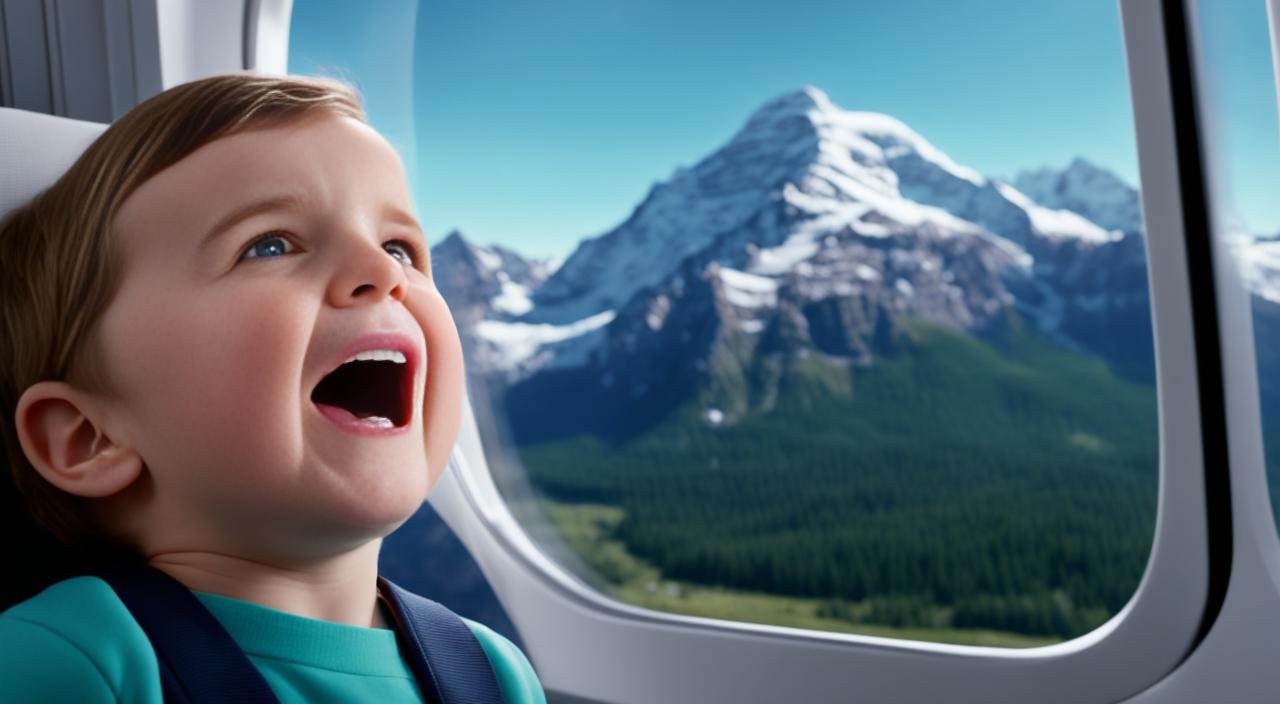Airplane ear, also known as ear barotrauma, can cause discomfort or pain in a child’s ears during flights. To prevent kids’ ear popping on planes and ensure a comfortable flight for your little ones, there are several effective strategies you can try. These include self-care techniques such as yawning, swallowing, or chewing gum, as well as using the Valsalva maneuver and providing distractions like favorite toys or pacifiers.
Additionally, there are preventive measures you can take before the flight, such as staying hydrated, avoiding flights when your child has a cold or ear infection, and using over-the-counter nasal sprays or decongestant pills with caution. With these kid-friendly ear popping prevention tips, you can reduce ear pain and discomfort in children during air travel.
Key Takeaways:
- Yawning, swallowing, and chewing gum can help equalize ear pressure during flights.
- The Valsalva maneuver can also help alleviate ear popping.
- Staying hydrated and avoiding flights with colds or ear infections can prevent ear discomfort.
- Using distractions like toys or pacifiers can divert your child’s attention from ear pain.
- Using over-the-counter nasal sprays or decongestant pills with caution can provide relief.
Understanding Airplane Ear and Its Symptoms
airplane ear, also known as ear barotrauma or barotitis media, occurs when there is an imbalance between the air pressure in the middle ear and the environment. This can cause discomfort or pain in the ear, along with symptoms such as ear fullness, muffled hearing, slight to moderate hearing loss, ringing in the ear (tinnitus), vertigo, and, in rare cases, bleeding from the ear.
When the air pressure in the environment changes rapidly during a flight, it can affect the eustachian tube, which connects the middle ear to the back of the throat. This tube helps equalize the pressure in the ear, but when it doesn’t function properly, it can result in the symptoms of airplane ear.
“I noticed that my child was constantly tugging at their ears during our recent flight. They complained of ear fullness and had difficulty hearing. I later learned that these were symptoms of airplane ear.”
– Parent testimonial
The discomfort caused by airplane ear can be distressing for both children and their parents. Understanding the symptoms can help you identify when your child is experiencing ear pressure and take appropriate measures to alleviate their discomfort.
By recognizing the signs of airplane ear, you can provide the necessary support and help your child have a more comfortable flying experience.
Causes and Risk Factors of Airplane Ear
Airplane ear, also known as ear barotrauma, occurs when there is a rapid change in air pressure during a flight. This sudden change can affect the eustachian tube, a narrow passage that connects the middle ear to the back of the throat. When the pressure in the middle ear and the environment is not balanced, it can result in discomfort or pain.
There are several causes and risk factors that can contribute to an airplane ear:
- Rapid air pressure changes: Climbing or descending in an airplane can lead to rapid changes in air pressure, affecting the eustachian tube.
- Scuba diving and hyperbaric oxygen chambers: Similar to flying, scuba diving and being in hyperbaric oxygen chambers involve changes in pressure that can impact the eustachian tube.
- Explosions nearby: Exposure to explosions or sudden loud noises can also disrupt the balance of pressure in the middle ear.
- Narrow eustachian tube: People with a narrower eustachian tube may be more susceptible to airplane ear.
- Common cold, sinus infection, and hay fever: These conditions can cause nasal congestion, making it more difficult for the eustachian tube to equalize pressure.
- Middle ear infection: An ongoing or recent middle ear infection can affect the eustachian tube’s ability to regulate pressure.
- Sleeping on an airplane: If a person sleeps during a flight without actively equalizing ear pressure through swallowing or yawning, they may be more prone to experiencing discomfort.
By understanding the causes and risk factors of airplane ear, you can take preventive measures to reduce the likelihood of your child experiencing ear pain on a plane. Implementing the self-care techniques and preventive measures discussed in this article can help alleviate discomfort and ensure a more enjoyable flight for your child.
Self-Care Techniques for Alleviating Airplane Ear
When it comes to alleviating airplane ear symptoms, self-care techniques can be highly effective. Encouraging your child to practice simple actions like yawning, swallowing, or chewing gum can help equalize the air pressure in their middle ear. These easy and kid-friendly techniques can provide quick relief from ear discomfort during flights.
“Yawning, swallowing, and chewing gum can help equalize air pressure in the middle ear.”
Another useful technique is the Valsalva maneuver. To perform this maneuver, have your child gently blow with their mouth closed while pinching their nostrils. This helps equalize the pressure in their ears and provides relief from the discomfort caused by the changing altitude.
“The Valsalva maneuver involves blowing gently with the mouth closed while pinching the nostrils.”
In some cases, using over-the-counter nasal sprays or decongestant pills can be effective in relieving nasal congestion and facilitating better equalization. It is important to consult with a healthcare professional before using any medication or nasal spray, especially if your child has specific medical conditions or allergies.
“Consulting with a healthcare professional before using nasal sprays or decongestant pills is advisable.”
If your child suffers from allergies, taking allergy medication before the flight can help minimize any potential nasal congestion and ease equalization. This can significantly reduce the chances of discomfort or pain during the journey.
“Taking allergy medication before the flight can alleviate nasal congestion and promote better equalization.”
Filtered earplugs are another self-care option that can provide slow and steady equalization of pressure against the eardrum during ascent and descent. These specially designed earplugs are safe and comfortable for children to use during flights, offering additional protection against ear discomfort.
“Filtered earplugs provide gradual equalization of pressure and protect against ear discomfort.”
By utilizing these self-care techniques, you can help your child find relief from ear popping and reduce the chance of experiencing ear pain during air travel. It’s important to remember that not all techniques work for everyone, so it may be helpful to try different methods to find what works best for your child.
| Self-Care Techniques for Alleviating Airplane Ear | Description |
|---|---|
| Yawning, swallowing, and chewing gum | Encourage your child to yawn, swallow, or chew gum to equalize air pressure in the middle ear. |
| Valsalva maneuver | Instruct your child to gently blow with their mouth closed while pinching their nostrils to equalize ear pressure. |
| Nasal sprays and decongestant pills | Under healthcare professional guidance, consider using over-the-counter nasal sprays or decongestant pills to relieve nasal congestion and facilitate better equalization. |
| Allergy medication | If your child has allergies, consult with a healthcare professional and consider taking allergy medication before the flight to minimize nasal congestion and promote better equalization. |
| Filtered earplugs | Use specially designed filtered earplugs to gradually equalize pressure against the eardrum during ascent and descent and protect against ear discomfort. |
Try these self-care techniques to ensure a more comfortable and enjoyable flying experience for your child.
Preventive Measures Before and During the Flight
To prevent child-ear discomfort during a flight, it is important to take certain preventive measures before and during the journey. By implementing these strategies, you can reduce the likelihood of your child experiencing ear pain or discomfort on a plane.
| Preventive Measures | Description |
|---|---|
| Avoid Flying with a Cold, Sinus Infection, or Ear Infection | Children with these conditions may be more susceptible to ear pain during flights. It is advisable to postpone travel until they have fully recovered. |
| Delay Travel After Ear Surgery | If your child has recently undergone ear surgery, consult with their doctor to determine when it is safe to fly. Giving ample time for healing can minimize the risk of complications. |
| Stay Hydrated | Proper hydration can help prevent congestion and soften mucus in the nasal passages, making it easier for your child to equalize ear pressure during ascent and descent. |
| Feeding During Ascent and Descent | Encouraging your child to drink or eat during the critical phases of the flight can promote swallowing and help equalize ear pressure. Offer a bottle, breastfeed, or provide a snack that requires chewing. |
| Provide Distractions | Entertaining your child with favorite toys, books, or engaging activities can help divert their attention and alleviate any discomfort they may experience during pressure changes. |
| Using Earplugs | Consider using specially designed earplugs for children that help regulate and control changes in pressure within the ears. These can provide additional protection during the flight. |
By following these preventive measures, you can ensure a more comfortable and enjoyable flying experience for your child.
How to Prepare Babies and Young Children for Airplane Ear

When traveling with babies and young children, it’s crucial to prepare them for the possibility of airplane ear. Explaining to your child that their ears might pop during the flight can help them mentally prepare for the experience and avoid unnecessary anxiety. Additionally, it’s wise to have your child’s ears examined by a doctor before the trip. This examination can identify any underlying conditions that may require medication or special precautions, ensuring their comfort throughout the journey.
Prioritizing hydration is also key in preventing congestion and discomfort caused by changes in air pressure. Be sure to keep your child well-hydrated before and during the flight. Bringing their favorite toys or pacifiers can provide a source of distraction, keeping their attention away from any discomfort they may experience. These familiar items can also help them feel comforted and secure, making the journey more enjoyable for both of you.
Using Earmuffs and Other Measures for Ear Protection
In addition to self-care techniques and preventive measures, there are other measures you can take to provide ear protection for your child during a flight. Baby earmuffs specifically designed for noise reduction can help minimize the impact of loud noises on your child’s ears. Using pacifiers, breastfeeding, or encouraging yawning during takeoff and landing can also help equalize ear pressure and provide relief. It is important to ensure that your child does not fall asleep during these critical phases of the flight, as swallowing is less frequent during sleep. Observing your child for signs of pain, such as covering their ears, can prompt you to take immediate action to alleviate their discomfort. By using earmuffs and implementing these additional measures, you can further protect your child’s ears during air travel.
| Earmuff Brand | Noise Reduction Rating | Age Range |
|---|---|---|
| Baby Banz Earmuffs | 31 dB | 0-2 years |
| Pro For Sho Baby Earmuffs | 34 dB | 0-2 years |
| Snug Kids Earmuffs | 27 dB | 6 months-8 years |
By using earmuffs, you can protect your child’s ears from excessive noise during the flight. Here are some popular brands of baby earmuffs, along with their noise reduction rating and recommended age range:
Conclusion
Ensuring comfortable flights for kids is a top priority for parents, and preventing airplane ear is an important step towards achieving that goal. By understanding the causes, symptoms, and risk factors of airplane ear, parents can take proactive measures to alleviate ear pressure and discomfort in their children.
Utilizing self-care techniques, such as yawning, swallowing, and chewing gum, can help equalize ear pressure and provide relief during flights. Implementing preventive measures like staying hydrated, avoiding travel when a child has a cold or ear infection, and using over-the-counter nasal sprays or decongestant pills with caution can also contribute to a more enjoyable journey.
Furthermore, using ear protection measures like earmuffs designed for noise reduction and encouraging yawning or sucking on pacifiers during takeoff and landing can help further protect the ears. By combining these strategies and taking the necessary precautions, parents can ensure a more comfortable and pain-free flying experience for their children.
FAQ
How can I prevent my child’s ears from popping on a plane?
To prevent your child’s ears from popping on a plane, you can encourage them to yawn, swallow, or chew gum. The Valsalva maneuver, which involves gently blowing with your mouth closed while pinching your nostrils, can also help equalize ear pressure. Providing distractions like favorite toys or pacifiers can alleviate discomfort as well. Staying hydrated, avoiding flights when your child has a cold or ear infection, and using over-the-counter nasal sprays or decongestant pills with caution are also effective preventive measures.
What are the symptoms of an airplane ear?
The symptoms of airplane ear include ear fullness, muffled hearing, slight to moderate hearing loss, ringing in the ear (tinnitus), vertigo, and, in rare cases, bleeding from the ear.
What causes airplane ear?
Airplane ear occurs due to a rapid change in air pressure during a flight. Factors such as climbing or descending in an airplane, scuba diving, hyperbaric oxygen chambers, or explosions nearby can cause it. Risk factors include having a narrow eustachian tube, common cold, sinus infection, hay fever, middle ear infection, or sleeping on an airplane without actively equalizing ear pressure.
What self-care techniques can help alleviate an airplane ear?
Self-care techniques like yawning, swallowing, chewing gum, and using the Valsalva maneuver can help equalize air pressure in the middle ear. Over-the-counter nasal sprays or decongestant pills, under the guidance of a healthcare professional, can also relieve nasal congestion. Filtered earplugs designed for children provide gradual equalization against the eardrum during ascent and descent.
What preventive measures can I take before and during the flight to prevent child ear discomfort?
To prevent child ear discomfort during a flight, it is advisable to avoid flying when your child has a cold, sinus infection, or ear infection. Staying hydrated before and during the flight can help soften mucus and prevent congestion. Feeding your child during ascent and descent, providing distractions like favorite toys, and using child-friendly earplugs can also help alleviate discomfort.
How can I prepare babies and young children for airplane ears?
You can prepare babies and young children for airplane ear by explaining to them that their ears might pop during the flight. Having their ears examined by a doctor can identify any underlying conditions that may require medication or special precautions. Ensuring proper hydration and providing distractions like toys or pacifiers can also help them cope with the pressure changes.
How can I provide ear protection for my child during a flight?
Baby earmuffs specifically designed for noise reduction can help minimize the impact of loud noises on your child’s ears. Using pacifiers, breastfeeding, or encouraging yawning during takeoff and landing can help equalize ear pressure. It is important to make sure your child does not fall asleep during these critical phases of the flight, as swallowing is less frequent during sleep. Observing your child for signs of pain, such as covering their ears, can prompt you to take immediate action to alleviate their discomfort.
What are some concluding thoughts on preventing kids’ ear popping on planes?
By understanding the causes, symptoms, and risk factors of airplane ear, parents can take proactive measures to alleviate ear pressure and discomfort in their children. Self-care techniques, preventive measures, and the use of ear protection measures can all contribute to a more pleasant flying experience for kids. By implementing these parental strategies for ear popping relief and taking the necessary precautions, parents can help their children have a more enjoyable and pain-free journey on an airplane.





